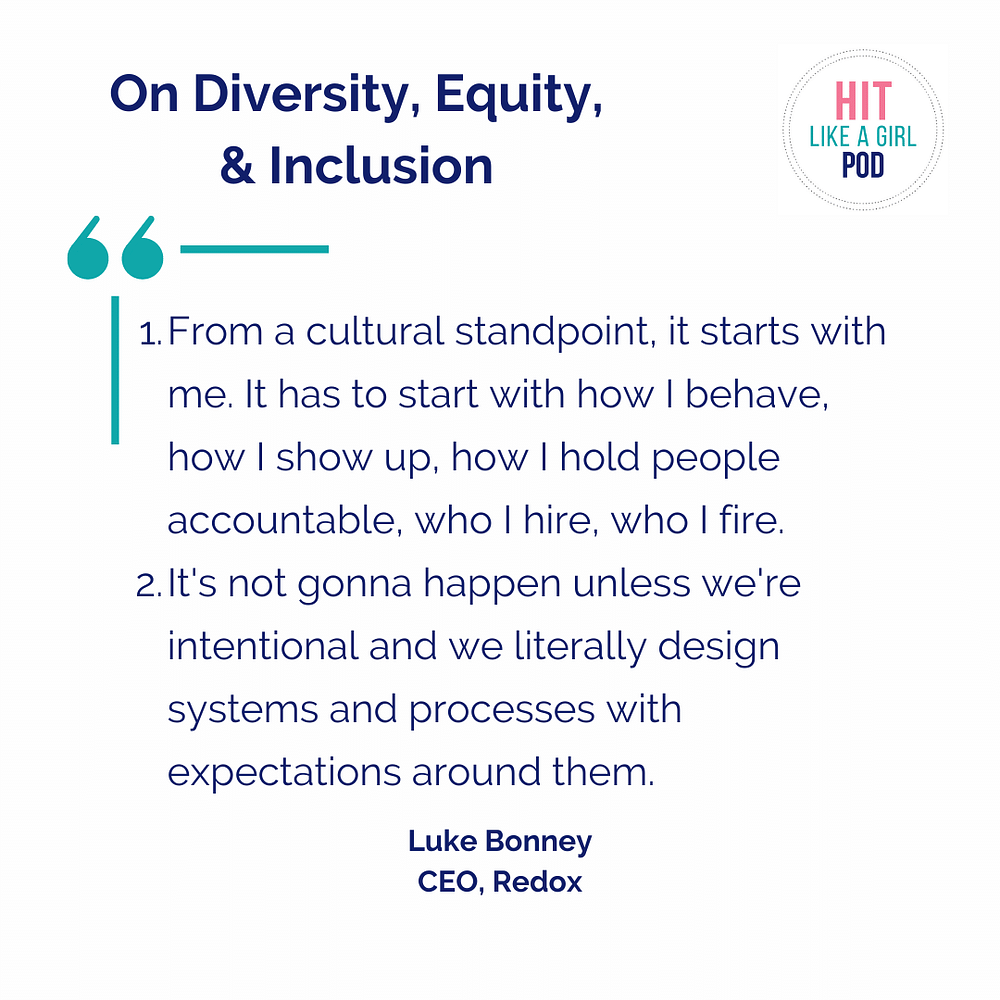
This conversation took place at HIMSS23 in Chicago, in collaboration with the HIMSS Women in HIT and Bluebird Leaders.
Shereese Maynard: Hello, I'm Shereese Maynard. I'm one of the partners at HIT Like a Girl Pod, and today we're going to introduce you to one of my favorite companies on the whole planet. I kid you not, and we are going to get into a…
Luke Bonney: I am already sweating.
Shereese Maynard: And we want you guys to, we only have a half hour with you guys today.
If you didn't come to coffee this morning, shame on you. It was amazing! So we have a half hour with our lovely company today, but we really wanna get into a deep dive about men as allies in this space and what companies can do to build better DEI programs. To tell you from where we are coming, I'm gonna give you a fact.
We now know Harvard Business Review reported that companies, where the men are invested in the DEI programs, do 90% better than those without, who only do 36% better in their productivity. DEI programs are important. It should be seamless, and we need to be open about the conversations we have about them. If your company is not inclusive, please let HIT Like a Girl know. We love taking care of those situations.
So without further ado, I wanna introduce you guys. If you don't know this company, where the hell have you been? This is Redox. This is the CEO of the mostest Luke Bonney. I'm gonna let him tell you a little bit about Redox, but this year, not do this year, but Redox brought on a Chief People Officer who is amazing.
Her background is amazing, and because she's a woman in Health IT, I was like, hell yeah. So I wanna introduce you to Chloe. I'm gonna let you tell you a little bit about themselves and then we're going to get into a discussion, and I'm going to ask you guys to ask your questions as we go along. Okay. Luke, take it away.
Luke Bonney: Okay. Yeah. I wonder what this morning's coffee experience is? So a little bit about Redox. We exist to help anybody building and scaling any sort of technology to integrate and share data anywhere. So whether you're building a telemedicine company, whether you're building an analytics platform, whether you're providing a technology that helps people provide care at home, you can use Redox to share data with any hospital, any clinic, any payer organization across the country.
We've been at it for a little while, since 2015, so today we're live and integrated with thousand and thousands of hospitals, even more clinics growing, number of payer organizations clinical networks, you name it. We've figured out how to get data in and out of whatever that endpoint might be. And the reason we started the company is really because we think that healthcare fundamentally lacks this kind of category of usable infrastructure that in every other industry has been necessary to really accelerate innovation to help accelerate the realization of new technology in market. That's what we do. Is there anything else? I wanna make sure I'm making... also, I have a dog Leroy, who is in our face shot here. I don't think any of you can see it, but Leroy is exactly eight years old, so he is exactly as old as Redox.
Chloe Drew: So I think you described Redox really beautifully.
I'll just say briefly. I've been doing DEI work really for my whole life. I've worked across every sector. I've worked in grassroots politics. I've worked in the public sector and government. I then moved into technology companies. I really firmly believe that DI is just the best human resources strategy.
And so that's how we do the work at Redox. And fortunately, and the reason that I came to Redox is because of Luke, pure and simple. I don't know if I've said it that directly before, but he lives and breathes allyship. It's just in his bones. He cares about this work and it's intentional, but I think it's very authentic and natural. And so we're excited for today's conversation.
Shereese Maynard: Thank you. So before we get too far into this, I wanna remind everybody, we do have a silent partner here today. Bluebird Leaders is also coupling with us on this particular event. So if you see them, tweet 'em, give 'em a thank you and a shout-out. OK, let's get into it.
I also wanna tell you guys, because I always give you something of value, right? Anytime I speak Redox I've been writing about how we need to now need to think about healthcare from a global lens. Redox is down in Canada and they are going to be the company that takes all of us global where you can get your care when and how you want it.
Mark my words. Write it down. You'll hear about it. Let's move on. Okay, so the first conversation we wanna have is about bravery. When we see companies with their DEI programs, one of the things that I noticed is that it's a lot of posturing. I think in some people of color, if you own companies, you know what that feels like.
It doesn't feel seamless or inclusive. It feels like there's just a policy somewhere that's supposed to work some way. And that's particularly true if you're a woman in the health IT space or if you're a person of color in the health IT space. But one of the things I liked about Redox, and their other person who's amazing Nico, who's not here, but one of the things I liked about them is that they're very transparent with the things that they try.
So my question to you guys is what made you decide to be open and transparent and take on the bravery of DEI?
|
Luke Bonney: Yeah, I don't really know if there's any other way to do it. When we really think about this question there's a couple of big things that we both believe and, honestly, have also learned the hard way. The first is, whether I like it or not, this whole way of thinking, and I think, way of being from a cultural standpoint, has to start with me. It has to start with me. It has to start with how I behave, how I show up, how I hold people accountable, who I hire, who I fire. |
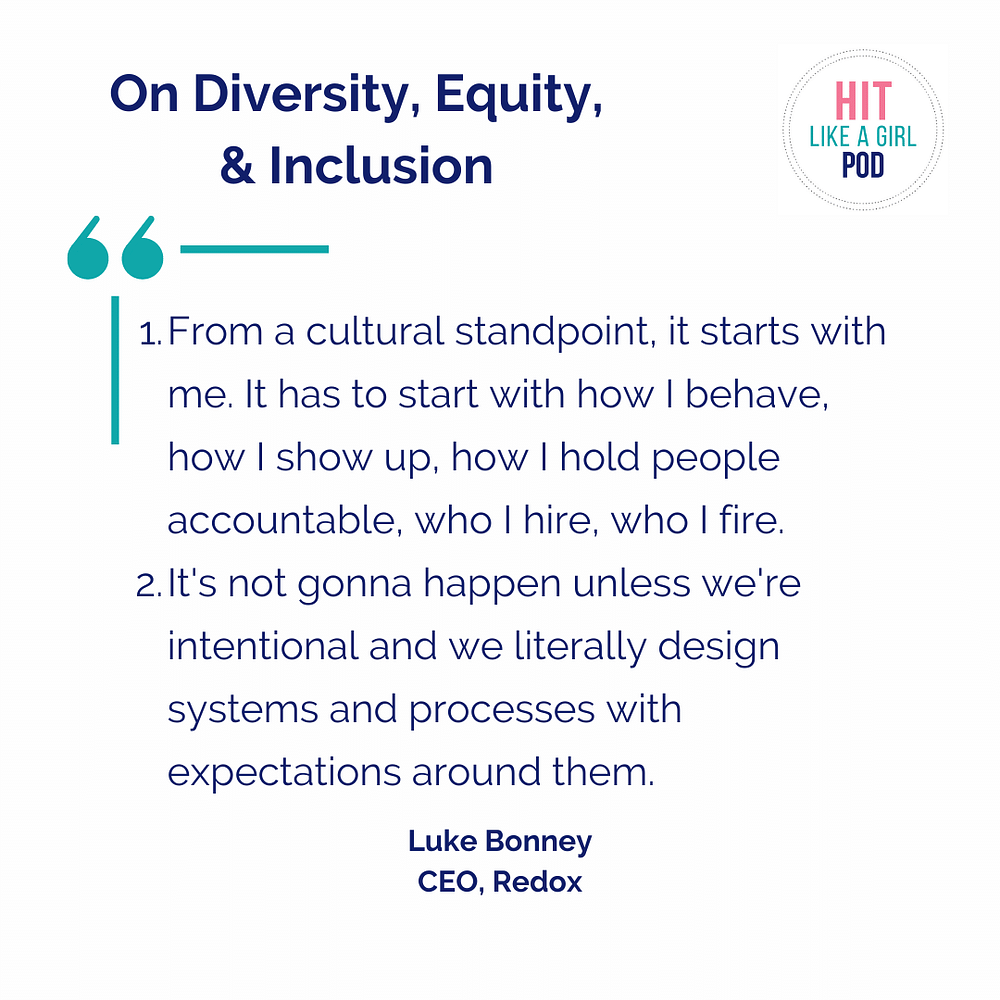 |
That's number one. Number two is it's not gonna happen unless we're intentional and we literally design systems and processes with expectations around it.
As an example, one of the things that we do at Redox is every single agenda has two framing sections, what we call rational objectives. So those are what you would expect. What are the business outcomes we're trying to drive with this meeting? And then what we call experiential objectives. And the experiential objectives are the things that we never think about, which is how do we literally want people to feel as part of this discussion?
You will not build an inclusive environment, unless you stop and ask the question, is how we're showing up literally giving rise to a sense of inclusion and belonging? And then the third is, again, how to make it transparent is in partnership with Chloe, we're rolling out, this is another example. We're rolling out performance management system for our executives.
That system includes five key behaviors that they're literally measured against, that they're literally comped against. And one of those behavior is do you build inclusive teams? And why is that included? It's included because it's the right thing to do, but it's also included because it literally drives better outcomes. Full stop.
So I don't know if that directly answers your question, but I know of no other way to do it. And a lot of what we do today is because we've tried and failed doing a bunch of other things. But those are some of the big things that underpin how we attack it and how we think about doing it transparently.
Shereese Maynard: Chloe, you and I have talked about being deliberate and you joining Redox. It's like a, she's just amazing. But tell me, what was your what was your plan when you came into an organization? Because healthcare IT is a little bit different than where you came from. What was your plan?
Chloe Drew: It's a really good question, and we've talked about companies that moved into the DEI space, let's say after George Floyd with a big bang and a lot of resources and a lot of hoopla. And some of them stayed with the work and a lot of them didn't stay with the work. And I think it's because for some companies it wasn't really structural, it wasn't really embedded.
And and I think they wanted a playbook. They wanted like a plug and play, here's how you do DEI work. And so I didn't come into Redox with a, this is how I do it and this is the playbook for culture. And this is the playbook for doing people culture and HR work and DEI work. I really tried to learn the company deeply, and I think Luke did a really good job with the management team of acculturating me.
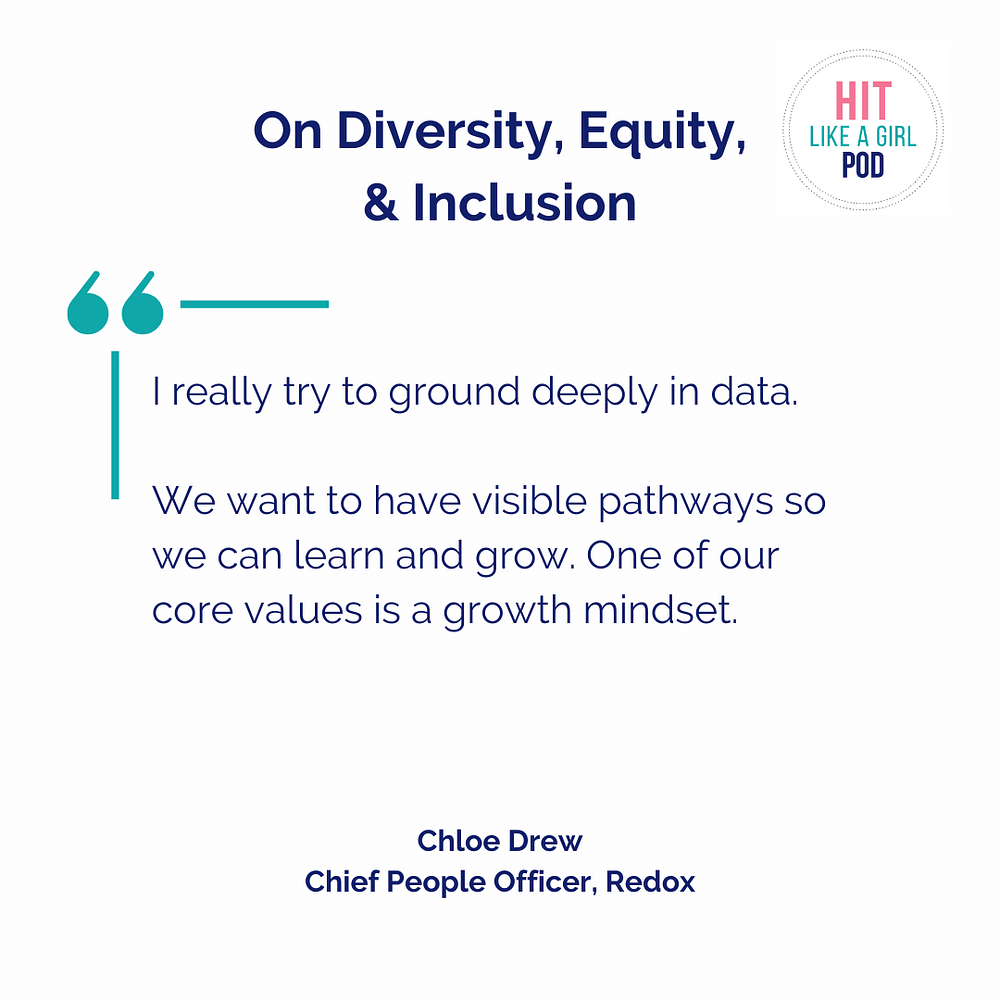 |
We spent time, we're a fully distributed company. We spent a lot of time getting to know each other in person, which was profound and important. I spent a lot of time trying just understand the business, like how do we make money? What do we need different people on different teams to be doing? What's gonna motivate them? How do they learn? What are they gonna do if they fail? |
And then I really try to ground deeply in data. And try to understand what do Redoxers—it’s what we call our people-- what do they want? What do they need? What are the gaps in their experiences? And I had some hunches about stuff that we needed to do, but I wanted us to have a real mandate from Redoxers where they said to us, we need career growth.
We want to have visible pathways so we can learn and grow. One of our core values is a growth mindset. Show it to us show us how you actually do it. So one of the least perhaps sexy things that we're doing is we're building job levels, but I think it's pretty cool because it helps people see equal opportunity and the competencies that they need at any single stage.
It really is an equity, fairness, and DEI initiative, I believe, and we've tried to show people, you have asked us for this, and so here's, here it is. Here's the one we're gonna iterate as we go. We want feedback from you as we build this, and we're gonna learn it and improve on it over time.
Shereese Maynard: So again, and guys, feel free to raise your hand if have a question during the talk, but we all just went through or still going through tech layoffs that's hard with any company. But when it comes to your DEI talent, usually it's the last one in is the first one gone. How did you guys handle layoffs? Cause I know you went through a difficult time, but how do you do that in a way that it doesn't seem like it's impacting your DEI initiatives?
Luke Bonney: Yeah, I can take a first crack at this. The first thing is that it is literally the most gut-wrenching thing in the entire world. And for me the literal way I think about it is how you treat people as part of this transition is one of the singular, truest tests of your character as a company.
I just say that it's one of those things you have to look, you have to look right at it. You have to put yourself in the shoes of the people who've trusted you, who you love and say, what's this experience gonna be like for them? So, one of the things we did as part of this is we've invested in what we call the Redox Alumni program.
And my goal is, we'll never pretend that Redox is gonna be a place for everybody to work for their entire life, even though for some of us that might be true. But how can we think about this as an opportunity to build community. Where now what we do is when our customers have job openings, we post it to our alumni community.
When we have openings, we post it to our alumni community. We have alumni who work at prospects and customers and are giving us feedback and giving us insights. So, for us, it was this realization that being inclusive does not stop at the four walls of Redox. Being inclusive is a mindset and we can extend that beyond. So, I don't know if that directly answers your question, but that's at least the thinking and the approach that we try to live.
Chloe Drew: I think I would add, I was just thinking about this today actually, that a rift is devastating. It's a huge change. We've also reorganized parts of the company to make us more efficient, more effective, more nimble.
All of these big changes take change management and if you haven't invested in building trust and one of our core values is also belonging. Before these moments of change, you're really too late. And I can't take any credit for this ‘cause they've been doing this work for years. But the way we hire is against our values, the way we onboard embeds feelings of belonging and interpersonal trust and a growth mindset.
Our, we call them our coaches, but our manager scores, even after the rift, were off the charts because people still felt cared for and seen and invested in. And so we still also had people angry and upset and disillusioned. That's just the nature of what happens. But I think Redox has invested for so long in just deep human caring that we had a little bit of extra grace when we had to make some really tough calls.
Shereese Maynard: That's amazing. Does anybody have any questions about that process? I don't know if any of you have ever lost a job in the tech sector, but it is devastating for most people. The way companies handle it makes it a big difference for a lot of people. So, tell us about things that didn't work.
One of the things I love about Redox is how creative you guys are and that you will try things even if they don't work out. Tell us about some things that maybe didn't work that you said, oh, we gotta re-look at this.
| Luke Bonney: The first thing I would say is if you just look back at the beginning of the company, I think we fell into a situation that I think is true for a lot of companies. I and the two other co-founders, we were guys who we worked together previously, and when we got started there was no people team, there was no HR department. So, as we were trying to figure out how to run a company and none of us had done this before. |  |
One of the first things we did when we looked at hiring was hiring people we knew people in our network, which tended to be a bunch of guys. And really it was 2018, 2019 when it became clear based on feedback from across the company and the team that we were unbalanced. When we looked at the numbers, we were less than 30% female-identifying.
And that was not a fun moment. That was a moment where I felt I don't know if shame is the right word, but how the hell did we get in this position? And then we decided to do something about it. So, Tau, who is now our head of talent since then we've worked really hard and we're now at 43%, which is a huge improvement, but we're not gonna stop until we're at 51%. So, that's work that'll continue. The list of things we've screwed up is very long, but I just go back to the very beginning. There was fundamental things we had to put in place, but really the only way you, at least in my experience that we ever make progress is step one, is being willing to talk about the fact that we have a problem and being willing to be open and listen to folks across your company who, who are gonna raise their hand and say, Hey, something here needs to really change. So that's probably the primary.
Chloe Drew: I love that example. And I would just build on it and say I'd like what you said about communication and transparency is such a theme of today and just in the past eight months, it's so hard around big changes to make sure you're being transparent and communicative enough to bring people along, but not freak people out.
But we just had the experience that'd actually give our CFO credit for this during the Silicon Valley Bank crisis, which actually didn't impact us directly. He, over the weekend managed the crisis, but also so openly and honestly communicated to all Redoxers like they were real adults who cared about the future of the company. And it was this real high point, I think, in rebuilding trust in leadership. Oh, they told me all of the dirty facts and again, we were fine, but it was such an, we hold it up as an example of how to just treat people like the adults that they are.
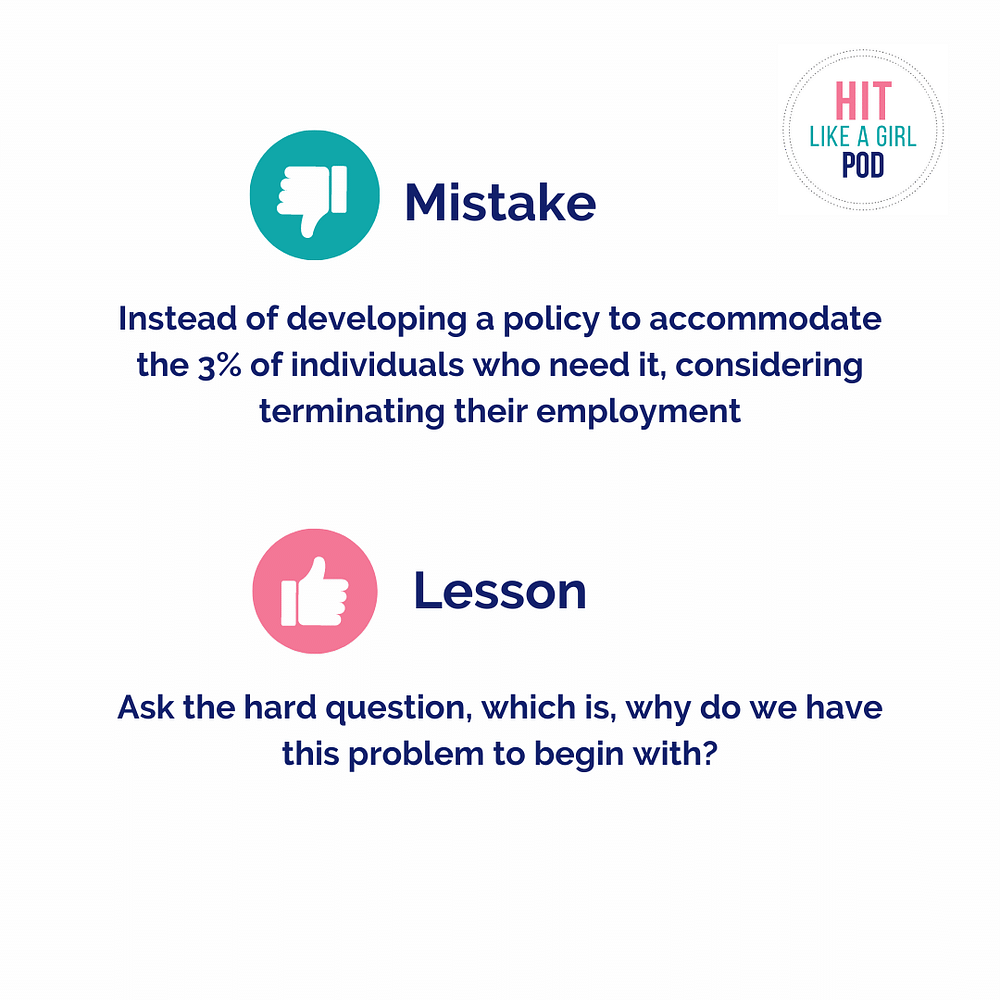 |
Luke Bonney: Maybe the last thing I would just add is we've fallen into this trap, but in terms of a mantra I think so many companies you talk about policy, you know I think one of the great mantras is, should we create policy for the 3% of people who need the policy, or should we just fire those 3% of people? And I think that's a hard thing to think about because it's easy to see a problem, provide a solution, and not ask the hard question, which is, why do we have this problem to begin with? |
But maybe that would just be the last thing in terms of tools or ways of thinking that have been helpful for us.
Shereese Maynard: So, in this industry, you do see a lot of male-led companies and one of the things that shows up for, I'm sure for most of us women are is accountability. So how do you hold yourselves accountable and how do the employees hold you guys accountable?
Chloe Drew: I'll just build on something that Luke said earlier. He talked about a new executive leadership 360 process that we're doing. So, what I would add to the great example that you brought up is, number one, we're telling the company that we're doing it. We're telling them what executive leadership behaviors we're holding ourselves accountable to if it's on our Confluence page. And we've also asked all of people's direct reports to weigh in. Not just, it's not just a peer review process. And I think it's such an important thing to do, particularly after a rift where people are like, we're not sure we can totally trust you guys at this exact moment.
So, we're saying, look, we want you to know that we are holding ourselves accountable to make tough calls, to be inclusive, to be incredibly business focused, also humble. So, I think that's one example. And Luke will be personally responsible for giving people feedback on that stuff. And as you said, evaluating and compensating.
Shereese Maynard: And I guess that was my question. Do you feel like the employees feel comfortable coming to you guys and saying, Hey, this isn't working, or this feels a certain way?
|
Luke Bonney: Yeah, I, this is another thing that I learned the hard way is I've for a long period of time I was like, if somebody wants to tell me something, they're just gonna knock on the door and say, Hey, I have something to tell you. That's true for some folks. Different folks have different ways they're comfortable communicating. Sometimes it needs to be anonymous, sometimes it has to be written, and sometimes it has to be verbal. |
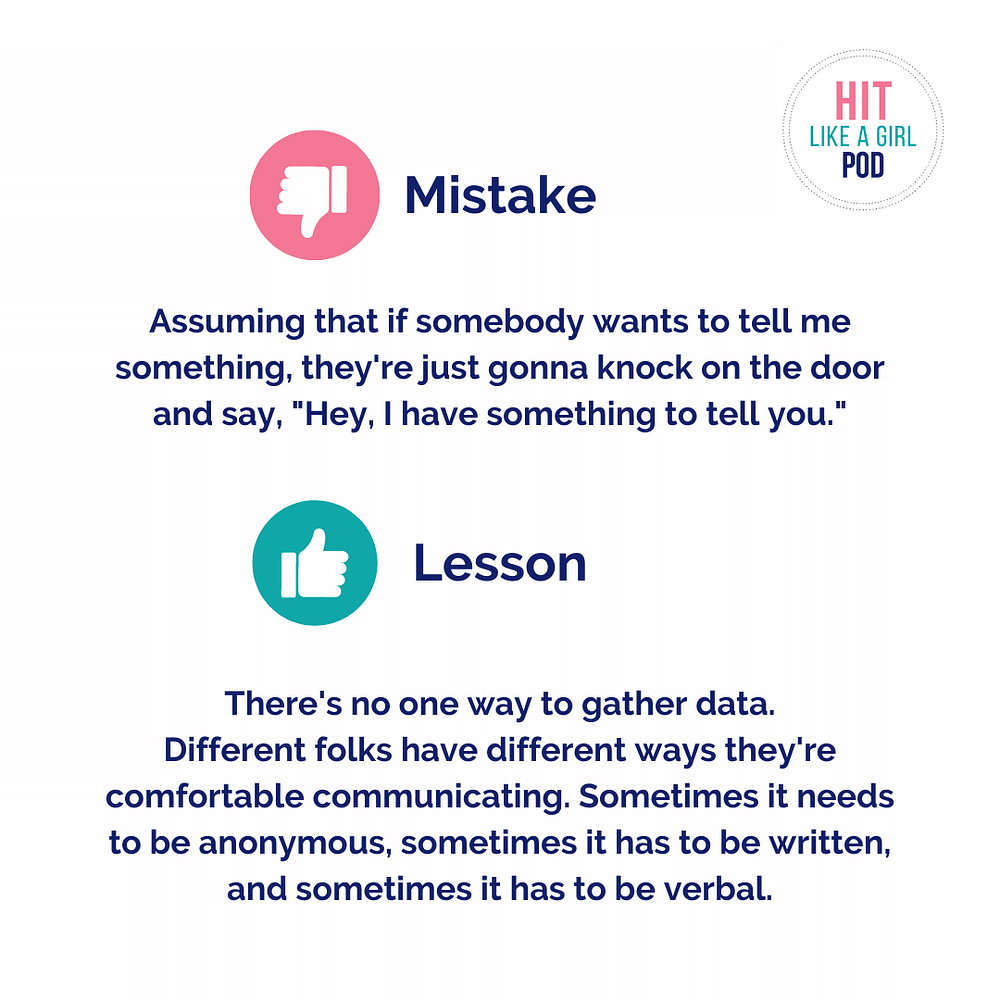 |
And that's an example where we've just had to learn through trial and error that if you really care about listening and learning from your organization, you have to provide multiple modes and methods to get that information out.
Some people do it in listening sessions in large meetings. Some people have to really sit and reflect individually. So, I think that the big thing is there's no one way to gather data. You have to do it in as many different ways as you can. And then I think one of the wonderful things about Chloe is she's incredibly data-driven.
Once she has data, we're going to action that data speaking from experience, working with her.
Chloe Drew: It helps to show people the bad data too. So when we talked about our annual engagement survey, we show people the places where we're doing well. And it's really important to start there and say, let's double down on you. Trust your coaches. We're a culture where you feel belonging. You've got a healthy work-life balance or “mix”, I think we're supposed to call it now 'cause there's never a balance. But we also showed them the places where you said, you think we're not doing well in these areas and we're gonna take action.
By the way, it's gonna be hard and it's gonna take a long time and we're not gonna get it right tomorrow, but we're all in this together.
Luke Bonney: And to be clear, Chloe was like, Hey, here's the slide you're presenting to the whole company tomorrow with our top scores and our bottom scores. Have fun.
Chloe Drew: You did great and it went over really well that you did it.
Shereese Maynard: I was about say, I think it's cool too because those scores, they're public with those scores. So, if they put it right out there, if they're not doing good in certain areas, you can see it right on their website. It's kinda amazing. So now I'm going to look for a few brave souls. I want somebody to tell me what their company's doing, right or not, or doing wrong, or just explain how you guys are handling it where you are.
Raise your hand, let us know. Who wants to be, there's gotta be, you look like you're very brave.
Audience Member: But when you were talking about increasing the women population at your company, what were your focus points?
Luke Bonney: One is like, where are the moments of accountability?
And I think the first and probably most important one is diversity of any candidate pipeline. So, it has to be super clear, and I think this is a level of accountability, whether you're the, you're your internal talent team or an external talent team, I need to see a fully represented set of candidates. That's number one.
| And that's like a big thing. I'll tell you something that is seemingly so small, but I hear about in almost every single onboarding session I do is, we have a section of any job posting that basically says women in underrepresented groups will not apply to a job if they feel like they don't meet a hundred percent of the requirements. | 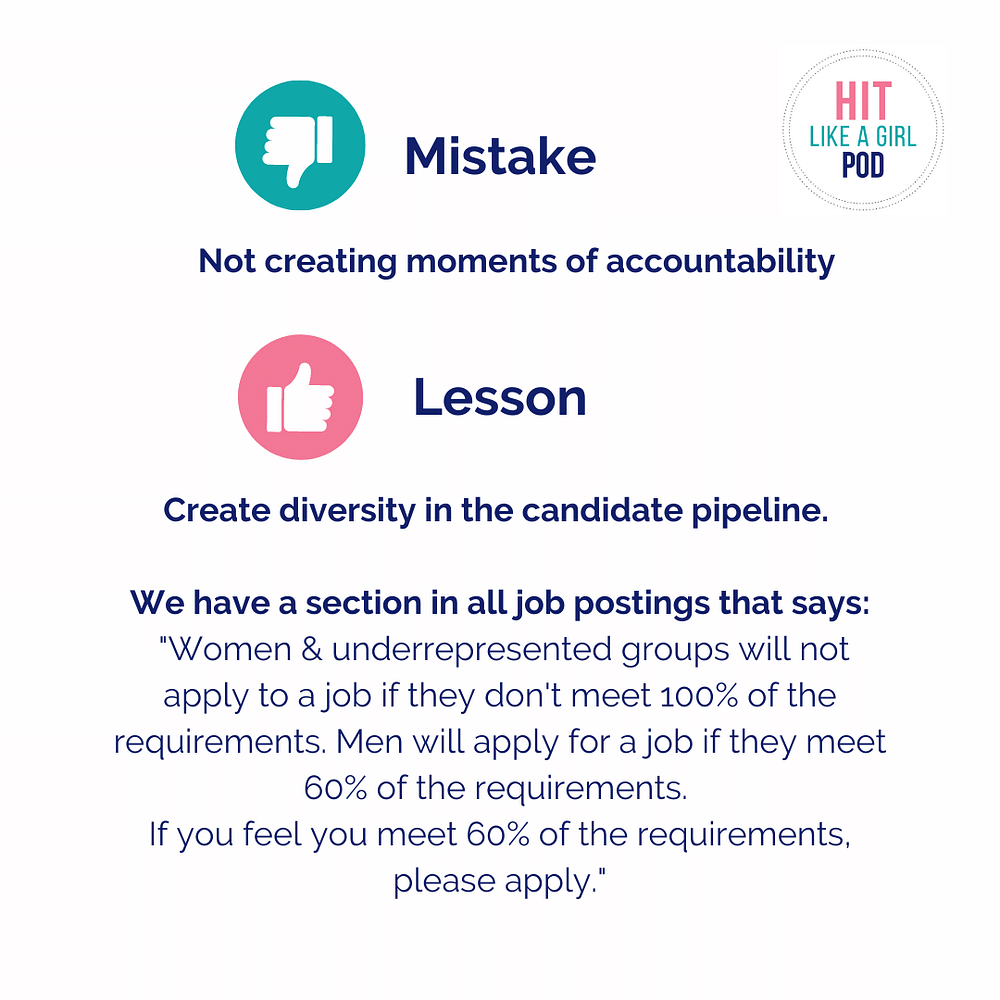 |
And men will apply to a job if they feel they meet 60% or more of the requirements. If you feel you need 60% of the requirements, please apply. And a person in our TA team, I get goosebumps thinking about it ‘cause I literally hear about it in onboarding, I would not be here. I hear this all the time. I would not be here if it didn't have that paragraph.
So, that's just a little tiny thing where you make it clear to the company that this is our intention. You make it clear to the company that we're serious. And that's just an example where somebody put that up with this intention and it had massive, outsized impact. So, there's lots of examples, but there's big things you can do, but there's little things you can do that have real oversized outcomes.
Shereese Maynard: Can I get another brave soul?
Oh, this is my partner and the CEO of HIT Like a Girl.
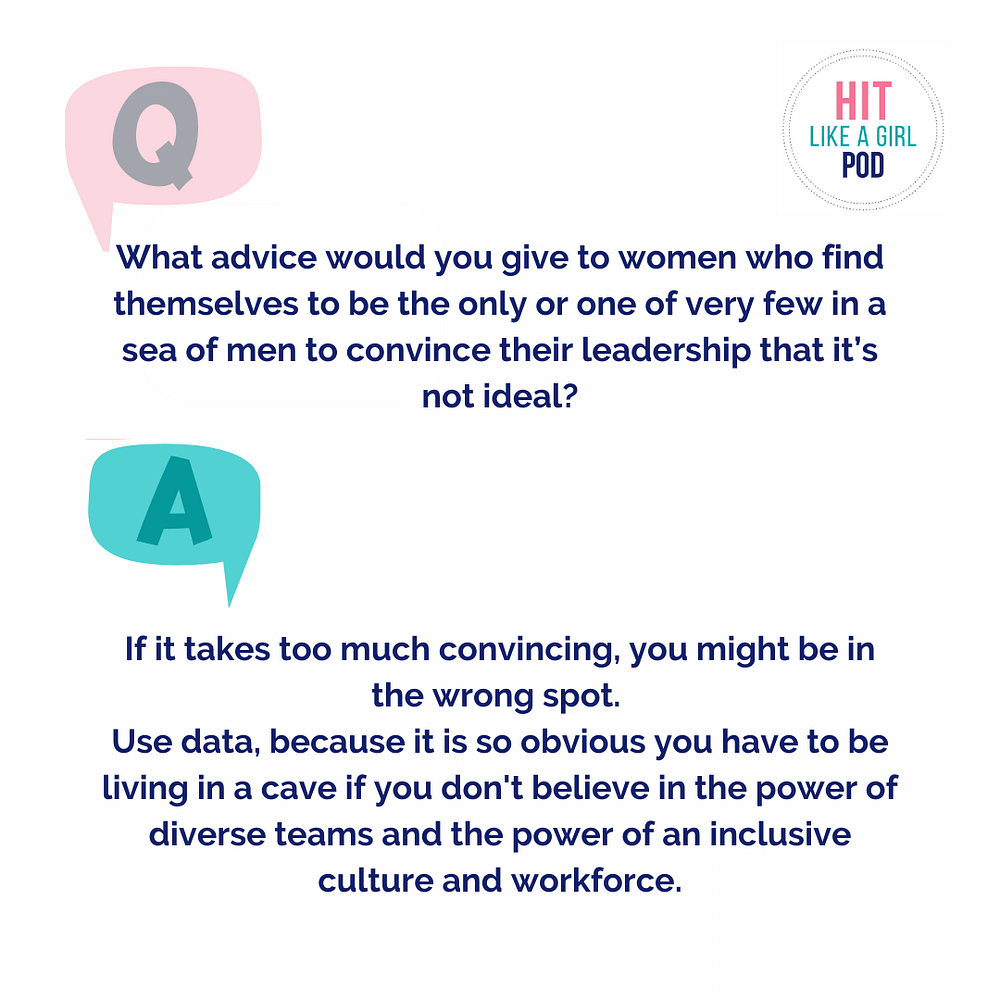 |
Joy Rios: I have a question and you may or may not be able to answer, but it's really for women who find themselves to be the only or one of very few in a sea of men, even if the organization is on the small side, what advice would you give to them to convince their leadership that that’s not ideal? Luke Bonney: This is gonna sound maybe not correct, if it takes too much convincing, you might be at the wrong spot, would be my first answer. My second answer is to use data because it is so obvious you, have to literally be living in a cave, if we don't believe in the power of diverse teams and the power of an inclusive culture and workforce. |
I dunno, I'm gonna stop with those two. Really interesting Chloe.
Chloe Drew: I think that's right. I think I've learned probably the hard way that people are convinced to work on DEI issues for a whole bunch of different reasons. And it doesn't have to be the reason you care. It can be, it's your family.
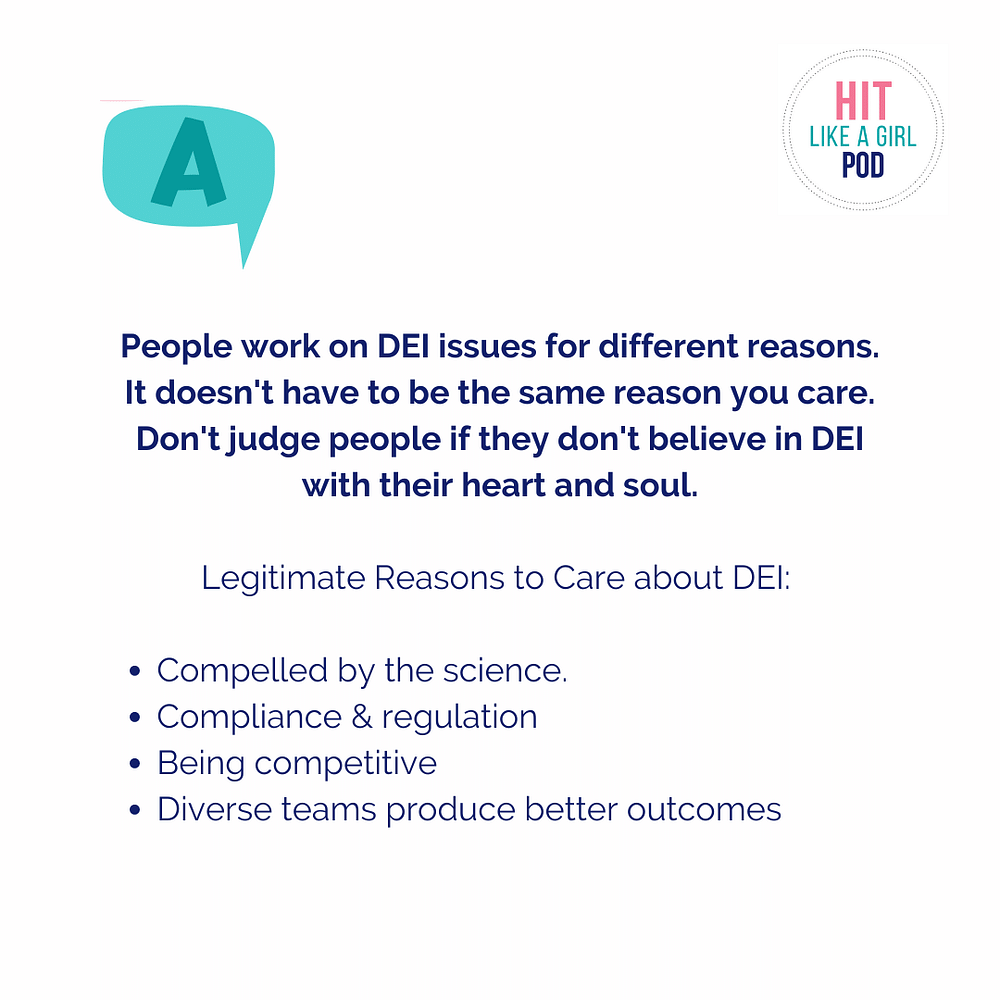 |
It can be you're compelled by the science. It can be that regulators are breathing down your neck and you simply have to. It can be you're competitive and you don't want another team to have a more diverse workforce than, so figuring out what moves people to take action, I think is a really important part of this work. And not judging them because they don't believe in it with their heart and soul. They're just competitive and they want to beat that guy. So, I think that's helpful to me in this work. I also just literally find bringing up the money vault example, to your point of diverse teams just literally produce better outcomes every single time. |
And like sports analogies sometimes works with dudes. But I really think tapping into why might you care and what might make you take a first step. The data's powerful. People are competitive. You show them this is what your team, this is what our company looks like, look at this company we're doing. My God, look at their returns.
Shereese Maynard: Does anybody else wanna be brave today? Julie, tell us about your company. Julie's with Carium. Carium was nice enough to sponsor our coffee talk this morning and they have great female leaders on their team as well.
Julie Wolk: Is this what happens when you come late? To be fair, one of the reasons I am late is I was recently offered a new role as CMO for our company and so I was attending a pre-board meeting.
Shereese Maynard: Oh, congratulations.
Julie Wolk: Yeah. So, some of that is leaning in, I think the good thing is that I've been tremendously supported. They recognize that there was certainly a need that said, as a female, I'm very allergic to ever being said that the reason I've got a role is because of my gender. Just because I've worked, excuse the term, but damn hard for many years to get there. And so luckily they, they lean into that. I think we still have a lot of work to do, particularly because we're health tech. I want to see more engineers on our team who are wicked smart and able to lean in there. And I also want to see people of color, people of various sexual orientations all represented on our team. That is what's really, ‘cuz it's the diverse nature of the people there leads to diverse thought.
|
Shereese Maynard: So, does anybody have any questions for Luke and Chloe? Joe. Joe's one of our allies. Thank you, Joe. Joe: I'll just yell it out. You mentioned about performance companies with better diversity. Procedures getting better performance. I'm wondering from your funders, are you getting any feedback in that direction? |
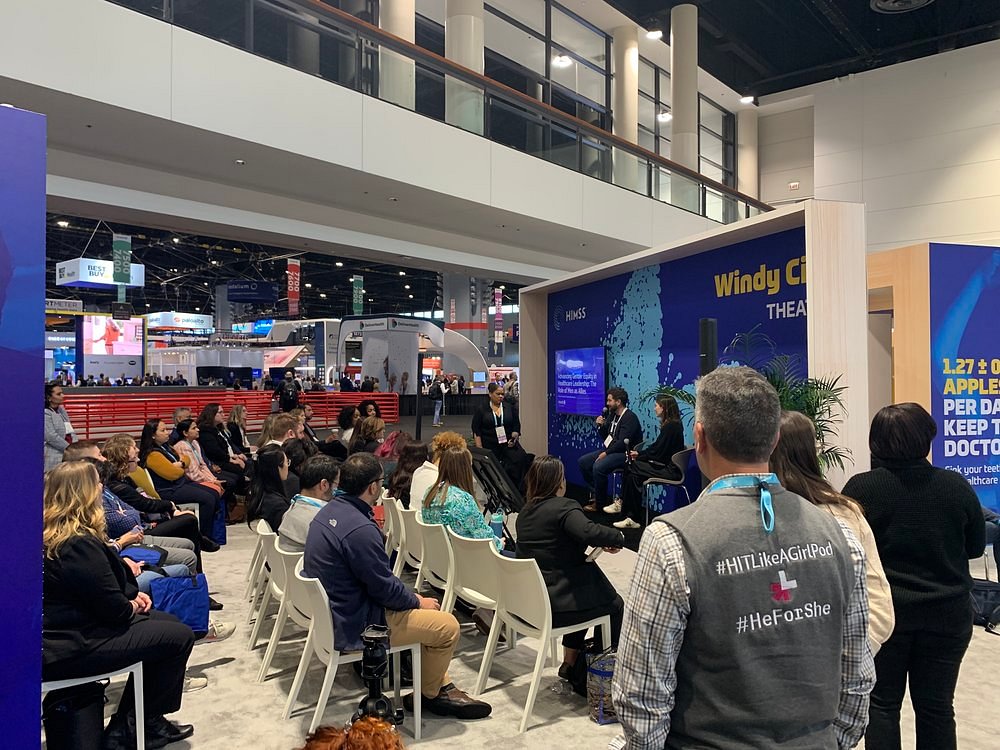 |
Luke Bonney: What do our investors think about...?
Joe: Yeah. Investors? Yeah, sorry.
Luke Bonney: I think like anything different, there's, I think Chloe said it really well, is you have to figure out what is motivating to that person or that individual. So, I don't think there's a blanket statement that they care about this thing or they care about the other thing.
What they all care about is do you hit your numbers? Are you gonna be successful? Are you going to continue to build differentiated product and figure out how to continue to innovate? And all of them are very smart and analytical and read all the same information that we read. That's the answer number one.
Answer number two I take the job of figuring out who our investors are gonna be very seriously. I was lucky enough when we were a little baby company and we did an angel round of investment, I got an angel investor who I didn't like very much, and I quickly figured out that it is a lifetime appointment. What that meant for me is we've raised at this point, 95 million dollars and in pretty much every example we have solved for a high-quality partner and a high-quality firm above total valuation, and that's because I need to I call it, the phone call test.
When something really bad happens in the middle of the night, am I gonna be able to pick up the phone and call this person? And are they gonna help me solve the problem or are they gonna yell at me? And that same phone call test is really a cultural alignment question. Does this person believe in the type of company we're trying to build?
So, that's probably the second answer to that question, is I think founders and CEOs, it's on us to be thoughtful on who will we accept as an investor? Because it makes a big, big difference.
There was one more question?
Audience Member: I was just gonna say, do you have any tips on coaching people to grow their skills in especially leaders in being more diverse in their approach towards hiring and managing teams to retain people? Because I think there's a big leadership gap in understanding that concept.
Chloe Drew: I think I'm gonna take the second half of your question, if that's okay, because, oh, just use us. We're doing less hiring this year. A lot of companies are doing less hiring, and so our ability to focus on DEI right now is really gonna be around culture building inclusion. I think one of the most powerful things a leader can do, which might sound a little strange, is to figure out a way to tap into the vulnerable, human side of themselves and to tell stories about why they care. And sometimes it takes some work and sometimes it takes talking to a trusted colleague about why does this matter to you? What were, what's a time that you might have felt excluded? When did you feel like you didn't belong?
Sharing that kind of story with teams can go far, because everybody feels that way and it can humanize a leader in such a powerful way and build psych safety in ways that have outsized impact over time. Hear more about things going wrong that are business problems, not business problems. It builds retention.
All the research shows that sort of psych safety and belonging and storytelling builds retention ‘cuz people feel like someone cares about them. So, it's really simple. But that would be, if I was gonna leave you with one thing, I would propose that.
Luke Bonney: I would just double down on that. I think we all know when the person sitting across from you is at that surface level and not giving it to you straight versus somebody who's willing to go there if it's a little bit of a scary conversation. And all I can say is you go there a couple times with members of your team and it becomes a lot easier and a lot more comfortable, and then you start to see them do that with others. So, they couldn't agree more. In terms of just building connection.
Shereese Maynard: Oh, did you have a question?
|
Fiona Harewood: How do you address bias in your company? So, we have various people who are great, but then there's, I know there's some subtle biases that they have. How do you address that in your company as part of your program? Chloe Drew: I'll use one very specific example. I was just talking about this with someone today. Companies get attracted to training everyone on unconscious bias, and it's in one ear or out the other. Some people care deeply. |
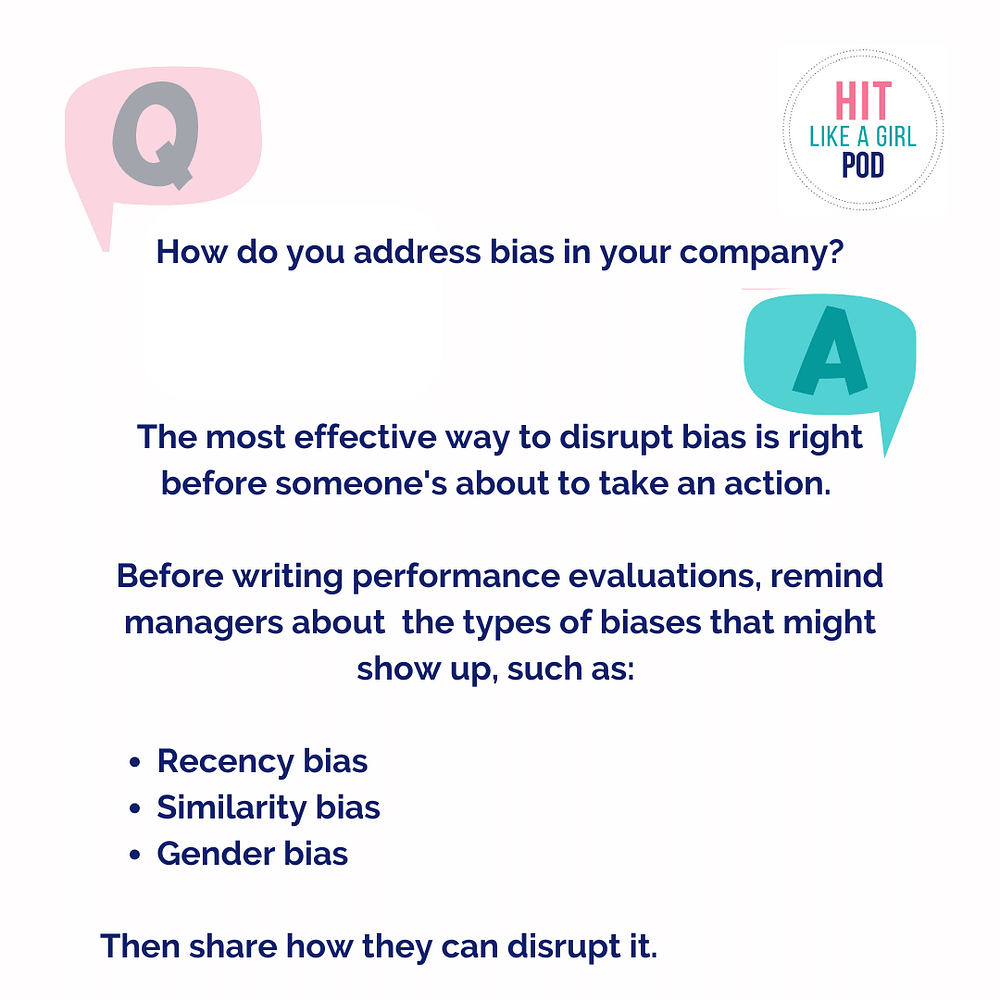 |
A lot of people forget about it. What the research shows is the most effective way is to disrupt bias right before someone's about to take an action. So, specifically before they're writing a performance evaluation, literally remind them, here's the four kinds of biases that might show up.
Recency bias, likeness or sameness bias, gender bias. Here's how it might show up in your evaluation, and here's how you specifically can disrupt it. Usually it's a specific example of this person's results or lack thereof. Don't rely on behavior or that you like them or don't like them.
In calibration meetings, we do the same thing. That's when you get around and talk about everybody's performance and we remind people, here's the kind of biases we're gonna be looking for, and here's how to disrupt them in yourself. It's just how adults learn. And so, it can be to your point about, Shereese talked a little about seamless integration, seamlessly integrated structurally is I think the better approach.
Shereese Maynard: So, we're gonna go ahead and close it out. I want to take a moment to thank all the gentlemen who came and showed up for us. Thank you for the allyship. We have particular gentlemen, Joe Desidario, Matt Fisher, and John Lynn from Healthcare Scene who always show up for us every single time we love them.
And Luke, you guys know, he's very much into it. We're gonna thank them. And as always, I always leave you with some value. So to our brave women, please email us at HIT Like a Girl Pod – we’re going to send you a Sephora gift card.
Thank you, everybody. Thank you for joining us and please give them a round of applause.



